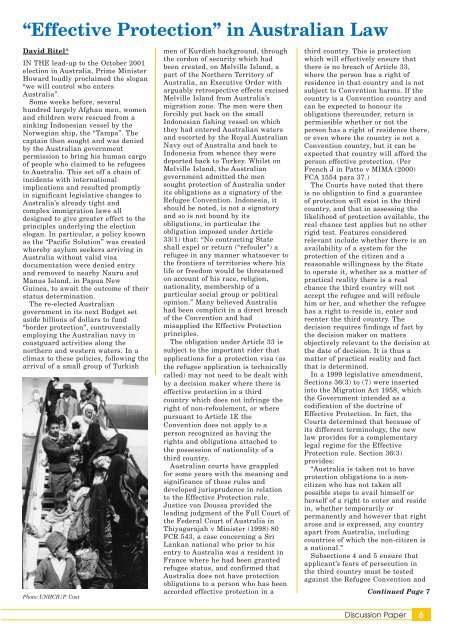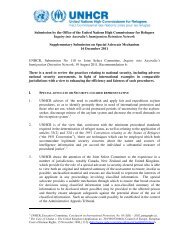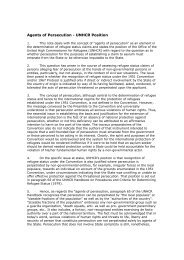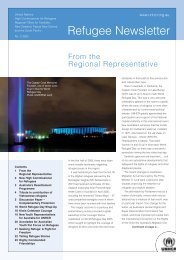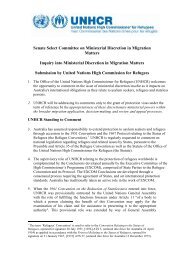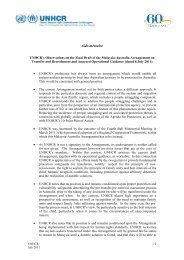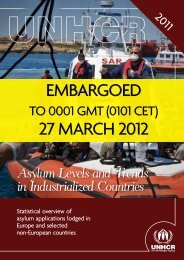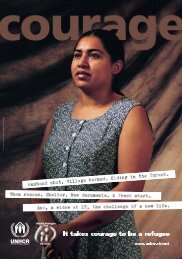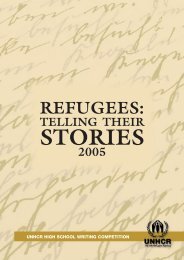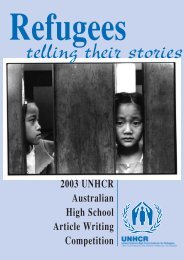download newsletter - unhcr
download newsletter - unhcr
download newsletter - unhcr
You also want an ePaper? Increase the reach of your titles
YUMPU automatically turns print PDFs into web optimized ePapers that Google loves.
“Effective Protection” in Australian Law<br />
David Bitel*<br />
IN THE lead-up to the October 2001<br />
election in Australia, Prime Minister<br />
Howard loudly proclaimed the slogan<br />
“we will control who enters<br />
Australia”.<br />
Some weeks before, several<br />
hundred largely Afghan men, women<br />
and children were rescued from a<br />
sinking Indonesian vessel by the<br />
Norwegian ship, the “Tampa”. The<br />
captain then sought and was denied<br />
by the Australian government<br />
permission to bring his human cargo<br />
of people who claimed to be refugees<br />
to Australia. This set off a chain of<br />
incidents with international<br />
implications and resulted promptly<br />
in significant legislative changes to<br />
Australia’s already tight and<br />
complex immigration laws all<br />
designed to give greater effect to the<br />
principles underlying the election<br />
slogan. In particular, a policy known<br />
as the “Pacific Solution” was created<br />
whereby asylum seekers arriving in<br />
Australia without valid visa<br />
documentation were denied entry<br />
and removed to nearby Nauru and<br />
Manus Island, in Papua New<br />
Guinea, to await the outcome of their<br />
status determination.<br />
The re-elected Australian<br />
government in its next Budget set<br />
aside billions of dollars to fund<br />
“border protection”, controversially<br />
employing the Australian navy in<br />
coastguard activities along the<br />
northern and western waters. In a<br />
climax to these policies, following the<br />
arrival of a small group of Turkish<br />
Photo: UNHCR/P. Coat<br />
men of Kurdish background, through<br />
the cordon of security which had<br />
been created, on Melville Island, a<br />
part of the Northern Territory of<br />
Australia, an Executive Order with<br />
arguably retrospective effects excised<br />
Melville Island from Australia’s<br />
migration zone. The men were then<br />
forcibly put back on the small<br />
Indonesian fishing vessel on which<br />
they had entered Australian waters<br />
and escorted by the Royal Australian<br />
Navy out of Australia and back to<br />
Indonesia from whence they were<br />
deported back to Turkey. Whilst on<br />
Melville Island, the Australian<br />
government admitted the men<br />
sought protection of Australia under<br />
its obligations as a signatory of the<br />
Refugee Convention. Indonesia, it<br />
should be noted, is not a signatory<br />
and so is not bound by its<br />
obligations, in particular the<br />
obligation imposed under Article<br />
33(1) that: “No contracting State<br />
shall expel or return (“refouler”) a<br />
refugee in any manner whatsoever to<br />
the frontiers of territories where his<br />
life or freedom would be threatened<br />
on account of his race, religion,<br />
nationality, membership of a<br />
particular social group or political<br />
opinion.” Many believed Australia<br />
had been complicit in a direct breach<br />
of the Convention and had<br />
misapplied the Effective Protection<br />
principles.<br />
The obligation under Article 33 is<br />
subject to the important rider that<br />
applications for a protection visa (as<br />
the refugee application is technically<br />
called) may not need to be dealt with<br />
by a decision maker where there is<br />
effective protection in a third<br />
country which does not infringe the<br />
right of non-refoulement, or where<br />
pursuant to Article 1E the<br />
Convention does not apply to a<br />
person recognized as having the<br />
rights and obligations attached to<br />
the possession of nationality of a<br />
third country.<br />
Australian courts have grappled<br />
for some years with the meaning and<br />
significance of these rules and<br />
developed jurisprudence in relation<br />
to the Effective Protection rule.<br />
Justice von Doussa provided the<br />
leading judgment of the Full Court of<br />
the Federal Court of Australia in<br />
Thiyagarajah v Minister (1998) 80<br />
FCR 543, a case concerning a Sri<br />
Lankan national who prior to his<br />
entry to Australia was a resident in<br />
France where he had been granted<br />
refugee status, and confirmed that<br />
Australia does not have protection<br />
obligations to a person who has been<br />
accorded effective protection in a<br />
third country. This is protection<br />
which will effectively ensure that<br />
there is no breach of Article 33,<br />
where the person has a right of<br />
residence in that country and is not<br />
subject to Convention harms. If the<br />
country is a Convention country and<br />
can be expected to honour its<br />
obligations thereunder, return is<br />
permissible whether or not the<br />
person has a right of residence there,<br />
or even where the country is not a<br />
Convention country, but it can be<br />
expected that country will afford the<br />
person effective protection. (Per<br />
French J in Patto v MIMA (2000)<br />
FCA 1554 para 37.)<br />
The Courts have noted that there<br />
is no obligation to find a guarantee<br />
of protection will exist in the third<br />
country, and that in assessing the<br />
likelihood of protection available, the<br />
real chance test applies but no other<br />
rigid test. Features considered<br />
relevant include whether there is an<br />
availability of a system for the<br />
protection of the citizen and a<br />
reasonable willingness by the State<br />
to operate it, whether as a matter of<br />
practical reality there is a real<br />
chance the third country will not<br />
accept the refugee and will refoule<br />
him or her, and whether the refugee<br />
has a right to reside in, enter and<br />
reenter the third country. The<br />
decision requires findings of fact by<br />
the decision maker on matters<br />
objectively relevant to the decision at<br />
the date of decision. It is thus a<br />
matter of practical reality and fact<br />
that is determined.<br />
In a 1999 legislative amendment,<br />
Sections 36(3) to (7) were inserted<br />
into the Migration Act 1958, which<br />
the Government intended as a<br />
codification of the doctrine of<br />
Effective Protection. In fact, the<br />
Courts determined that because of<br />
its different terminology, the new<br />
law provides for a complementary<br />
legal regime for the Effective<br />
Protection rule. Section 36(3)<br />
provides:<br />
“Australia is taken not to have<br />
protection obligations to a noncitizen<br />
who has not taken all<br />
possible steps to avail himself or<br />
herself of a right to enter and reside<br />
in, whether temporarily or<br />
permanently and however that right<br />
arose and is expressed, any country<br />
apart from Australia, including<br />
countries of which the non-citizen is<br />
a national.”<br />
Subsections 4 and 5 ensure that<br />
applicant’s fears of persecution in<br />
the third country must be tested<br />
against the Refugee Convention and<br />
Continued Page 7<br />
Discussion Paper<br />
6


